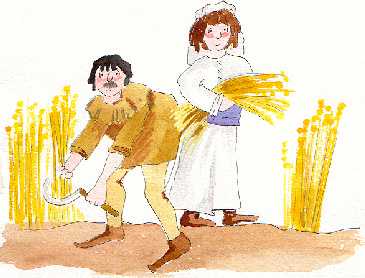 |
 |
 |
| |
In Medieval Europe, more than 90 per cent of the population lived in rural communities and worked on the land. Farming was a full-time job, as methods were ancient and not very efficient. The Lord's manor used to consist of a village, the lord's house or castle, a church and the surrounding farmland. The lord governed the community and appointed officials who made sure that the villagers carried out their duties. The lord lived on his estate in his manor house. He also acted as the judge in the manor court and had the power to punish those who broke the law. Work on the manor was planned by the reeve - the bailiff or right-hand man - chosen as the peasants' spokesman. The bailiff, who took orders from the lord's steward. |
|
| |
 |
|
The village was divided into 2 or 3 large fields, divided then into narrow strips of land. Each peasant had strips in different parts of the field, so that they all shared good and poor land. They used to grow rye, oat, peas and barley. The peasants' lives were linked to the natural cycle, the weather and the seasons. They got up at dawn and went to bed at dusk. So, they used to spend most of the daylight hours outside. |
|
| |
60 per cent of the peasants weren't free. They were serfs or villeins ( villagers ) and were property of the lord of the manor, who could buy and sell them as he pleased. Known as serfs or villeins, peasants were forced to work for the lord, who allowed them to farm their own piece of land in return. So, most families rented a small piece of land in the huge, open fields which belonged to the lord or the church, paying them a percentage of the yield. They also used to rent their houses to the lord, as few owned the dwellings where they lived. Fortunately, the tradition of the manor dictated that if a serf died, his son would "inherit his father' s land by paying a fine, of course, and also paying the Death duty. This usually consisted of the best beast or most valuable possession, which would be given to the lord, and then the second best one, which would be given to the Church. Apart from that, all vassals had to pay their lord a relief, consisting of money, food or goods, at certain time. By paying a fine, a peasant could marry outside his own manor, go on a pilgrimage or educate his son buying him an apprenticeship or having him admitted to the priesthood. But life for the peasants was hard nt only due to their services to the lord, but also because they had to give a tithe, a tenth of whatever they produced (crops, firewood, flour, eggs and meat) to the local priest. So, these tithes made some churches very wealthy, as well as unpopular. They also had to pay the miller to have their corn grounded at the lord's mill and to take wood from the forest. As you can see, most poor people used to work the land, but there were few exceptions, such as the smiths, who forged the metal, shoed horses and repaired tools. |
|
| |
 |
|
The diet of the poor peasants
was based on vegetables; cereals (oat, barley and wheat) eaten in the form of porridge, broths, stews and bread. They didn't use to have much meat, eggs or fish to eat. But if they had animals, these were slaughtered in November to provide food for the cold winter months. The wool from sheeps and goats was used to make clothes, and any excess of the food they produced was sold at the markets to supply the town people. Then, peasants could increase their income. However, we must take into account that among the poor people bartering was very common- they used to exchange goods without money changing hands. This food was cooked on open fireplaces inside a huge pot placed on the flames. Knives and spoons were the only cutlery used. |
|
| |
Poor people used to supplement their diet by hunting wild animals on common land. But if they were caught poaching on the lord's estate, they would be surely punished. Persistent offenders used to be executed. However, you can guess then that colds and mild fevers were fatal, as they were already weakened by their poor diet. |
|
| |
At home,
living conditions were harsh as the whole family used to share one same room, sleeping, eating and spending their freetime in the same place. The peasants' dwellings used to take the form of a long house, with accommodation for the family at one end, and the byre for cattle at the other. The walls were made of wattle and daub, and the floor was bare earth. The only room had a hearth in the centre, which was used as a fireplace, and contained basic furniture, such as a table, a bench, a chest for clothes and straw mattresses to sleep on. Tableware consisted of pottery jars and bowls. Flat pieces of bread called trenchers were used instead of plates and then were eaten. The only source of artificial light were the candles made of melted animal fat. So it must have been very dark and smoky inside. |
|
 |
|
 |
Drawing activity Draw your peasant's house in the manor. Draw both the exterior and the plans for the inside. |
|
 |
 |